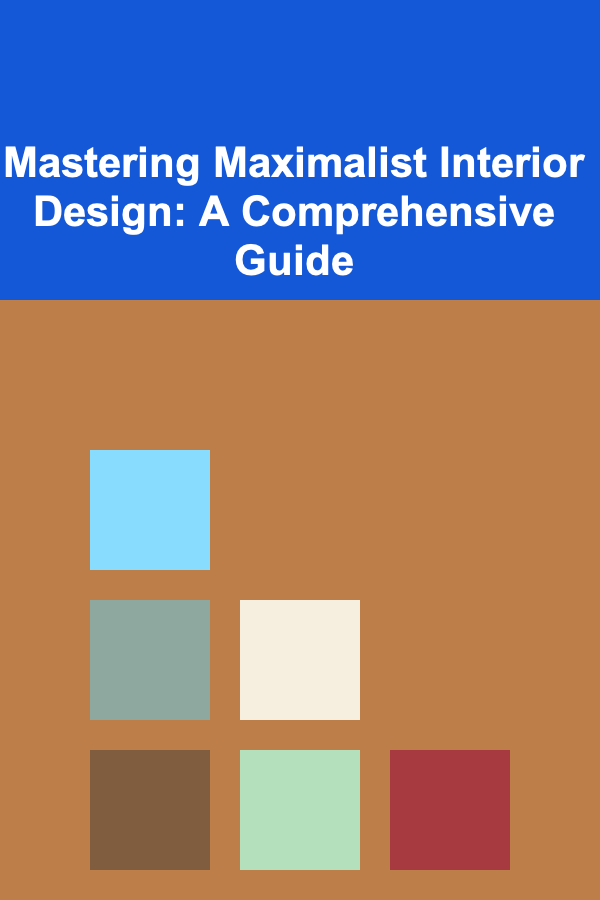
Mastering Maximalist Interior Design: A Comprehensive Guide
ebook include PDF & Audio bundle (Micro Guide)
$12.99$5.99
Limited Time Offer! Order within the next:

Maximalist interior design, often perceived as the antithesis of minimalism, is a bold and expressive approach to decorating that embraces abundance, eclecticism, and a curated sense of personal style. Far from being a chaotic free-for-all, successful maximalism requires a keen eye, thoughtful planning, and a strong understanding of design principles. This guide provides a comprehensive exploration of maximalist design, offering practical advice and insights to help you create a visually stunning and personally meaningful space.
Understanding the Core Principles of Maximalism
Before diving into the specifics, it's crucial to grasp the fundamental principles that underpin maximalist design. These aren't rigid rules, but rather guiding concepts that help structure the seemingly chaotic abundance:
- Intentional Layering: Maximalism is about layering textures, patterns, and objects to create depth and visual interest. This isn't simply piling things up; it's a deliberate process of adding elements that complement and enhance each other. Think of it like composing a painting, where each layer contributes to the overall impact.
- Eclectic Fusion: Maximalism embraces a mix of styles, eras, and origins. Antiques can sit comfortably alongside modern art, vintage finds can complement contemporary furniture, and global influences can blend seamlessly. The key is to find a common thread or unifying element that ties everything together.
- Personal Narrative: More than any other style, maximalism is about expressing your personality and telling your story. The objects you display should reflect your interests, passions, and experiences. This personal connection is what makes a maximalist space feel truly authentic and unique.
- Controlled Chaos: While maximalism embraces abundance, it shouldn't devolve into actual clutter. There's a fine line between a curated collection and a disorganized mess. Maintaining a sense of order and visual balance is essential to preventing the space from feeling overwhelming.
- Bold Color Palette: Maximalist spaces often feature vibrant and saturated colors, used liberally and confidently. Don't be afraid to experiment with unexpected combinations and bold contrasts. However, understanding color theory and using it intentionally is key to avoiding visual clashes.
Developing Your Maximalist Vision: Identifying Your Style and Inspiration
The first step in mastering maximalist design is to define your personal style and gather inspiration. This will help you create a cohesive and authentic space that reflects your unique taste.
Exploring Your Personal Style
Consider the following questions to help identify your design preferences:
- What colors are you drawn to? Do you prefer warm and inviting tones, cool and calming hues, or bold and vibrant shades?
- What patterns do you find appealing? Are you drawn to florals, geometrics, abstracts, or a combination of styles?
- What eras or design movements resonate with you? Do you love the glamour of Art Deco, the bohemian spirit of the 1970s, or the ornate details of Victorian design?
- What materials and textures do you prefer? Do you like the warmth of natural wood, the softness of velvet, the coolness of metal, or the tactile appeal of woven fabrics?
- What objects do you collect? Do you have a passion for vintage ceramics, antique maps, contemporary art, or travel souvenirs?
Gathering Inspiration
Once you have a better understanding of your personal style, start gathering inspiration from various sources:
- Interior Design Magazines and Websites: Browse publications like Architectural Digest, Elle Decor, and House Beautiful for examples of maximalist interiors. Pay attention to the color palettes, furniture arrangements, and styling details that appeal to you.
- Social Media Platforms: Explore platforms like Instagram and Pinterest for visual inspiration. Search for hashtags like #maximalism, #eclecticdecor, #bohemianinterior, and #colorfulhome to discover a wide range of maximalist styles. Create mood boards to collect your favorite images and ideas.
- Art Galleries and Museums: Visit art galleries and museums to expose yourself to different artistic styles and design movements. Pay attention to the colors, textures, and compositions that resonate with you.
- Travel and Cultural Experiences: Draw inspiration from your travels and cultural experiences. Visit local markets, explore historical sites, and immerse yourself in different cultures to discover unique colors, patterns, and objects.
- Your Own Belongings: Look at the items you already own and consider how they can be incorporated into your maximalist design. Your existing furniture, artwork, and accessories can serve as a starting point for your new space.
Creating a Cohesive Color Palette
Color is a powerful tool in maximalist design. While there are no hard and fast rules, a well-chosen color palette is essential for creating a cohesive and visually appealing space.
Choosing Your Base Color
Start by selecting a base color for your walls or large furniture pieces. This color will serve as the foundation for your palette. Consider the following factors when choosing your base color:
- Room Size and Lighting: In smaller rooms, lighter colors can help create a sense of spaciousness. In larger rooms, darker colors can add depth and drama. Consider the amount of natural light the room receives when choosing your base color.
- Desired Mood: Warm colors like reds, oranges, and yellows can create a cozy and inviting atmosphere. Cool colors like blues, greens, and purples can create a calming and relaxing environment.
- Personal Preference: Ultimately, the best base color is one that you love and that reflects your personal style.
Adding Accent Colors
Once you have chosen your base color, add several accent colors to create visual interest and depth. Don't be afraid to experiment with unexpected combinations and bold contrasts. Consider using the 60-30-10 rule as a guideline. 60% of the room is the dominant color, 30% is the secondary color, and 10% is the accent color. This helps create balance even with many colors in the space.
- Complementary Colors: Complementary colors are opposite each other on the color wheel. They create a high-contrast look that can be very striking. For example, blue and orange are complementary colors.
- Analogous Colors: Analogous colors are next to each other on the color wheel. They create a harmonious and cohesive look. For example, blue, blue-green, and green are analogous colors.
- Triadic Colors: Triadic colors are evenly spaced on the color wheel. They create a vibrant and balanced look. For example, red, yellow, and blue are triadic colors.
Incorporating Metallics and Neutrals
Metallics like gold, silver, and brass can add a touch of glamour and sophistication to your maximalist space. Neutrals like white, gray, and beige can provide a grounding element and prevent the space from feeling too overwhelming. Use them sparingly to highlight other colors and textures.
Mastering the Art of Layering Patterns and Textures
Layering patterns and textures is a key element of maximalist design. It adds depth, visual interest, and tactile appeal to the space.
Mixing and Matching Patterns
Don't be afraid to mix and match different patterns, but do so with intention. Consider the scale, color, and style of each pattern to ensure that they complement each other.
- Vary the Scale: Combine large-scale patterns with small-scale patterns to create visual balance. For example, pair a large floral print with a small geometric pattern.
- Repeat Colors: Choose patterns that share a common color to create a cohesive look. This will help tie the different patterns together.
- Consider the Style: Mix patterns from different eras or styles, but ensure that they have a common thread. For example, pair a vintage floral print with a modern geometric pattern, but choose patterns that share a similar color palette or aesthetic.
Layering Textures
Layering textures is just as important as layering patterns. Combine different materials to create a rich and tactile experience.
- Mix Soft and Rough Textures: Combine soft textures like velvet and silk with rough textures like linen and jute. This will create a sense of contrast and visual interest.
- Use Natural Materials: Incorporate natural materials like wood, stone, and leather to add warmth and authenticity to the space.
- Add Tactile Details: Use accessories with tactile details like fringe, tassels, and embroidery to add a playful touch.
Balancing Visual Weight
When layering patterns and textures, it's important to consider the visual weight of each element. Darker colors and larger patterns tend to have more visual weight than lighter colors and smaller patterns. Balance the visual weight of different elements to create a harmonious and visually appealing space. For example, pair a dark, heavily patterned sofa with lighter, more simply patterned cushions.
Selecting Furniture and Accessories: Curating Your Collection
The furniture and accessories you choose will play a crucial role in defining the character of your maximalist space. Curate a collection of pieces that reflect your personal style and tell your story.
Choosing Statement Pieces
Select a few statement pieces that will serve as focal points in the room. These could be a bold sofa, a striking armchair, a vintage cabinet, or a dramatic chandelier. These pieces should command attention and set the tone for the rest of the space.
Mixing Furniture Styles
Don't be afraid to mix furniture styles from different eras or origins. Pair antiques with modern pieces, vintage finds with contemporary designs. The key is to find pieces that complement each other in terms of scale, color, and style.
Accessorizing with Personality
Accessories are what truly bring a maximalist space to life. Use them to express your personality and showcase your interests.
- Display Your Collections: Showcase your collections of vintage ceramics, antique maps, contemporary art, or travel souvenirs. Arrange them in a visually appealing way to create a personal and meaningful display.
- Add Greenery: Plants add life, color, and texture to any space. Incorporate a variety of plants in different sizes and shapes to create a lush and vibrant atmosphere.
- Use Mirrors: Mirrors can reflect light and create a sense of spaciousness. Use them to highlight interesting features or to add a touch of glamour to the space.
- Incorporate Textiles: Use textiles like rugs, throws, and cushions to add warmth, texture, and color to the space. Choose textiles with interesting patterns and textures to create a layered and inviting look.
- Don't be Afraid of Clutter (Controlled Clutter!): Arrange objects in vignettes rather than just spreading them randomly. Group items that have a connection in color, theme, or material to create a visually appealing arrangement.
The Importance of Lighting
Good lighting is essential for any interior design, but it is particularly important in maximalist spaces. The many layers of objects and textures require careful illumination to prevent the space from feeling dark or cluttered.
- Layer Your Lighting: Use a combination of ambient, task, and accent lighting to create depth and dimension. Ambient lighting provides overall illumination, task lighting is used for specific activities, and accent lighting highlights particular features.
- Choose Statement Light Fixtures: A dramatic chandelier, a sculptural floor lamp, or a pair of eye-catching table lamps can add personality and style to the space.
- Use Warm Light Bulbs: Warm light bulbs create a cozy and inviting atmosphere. Avoid cool or harsh lighting, which can make the space feel sterile and unwelcoming.
- Consider Dimming Options: Installing dimmers allows you to adjust the lighting to suit different moods and activities.
Maintaining Order and Preventing Clutter
As mentioned earlier, maximalism is about controlled chaos. It's important to maintain a sense of order and prevent the space from feeling overwhelming.
Declutter Regularly
Even in a maximalist space, it's important to declutter regularly. Get rid of items that you no longer need or love. This will help prevent the space from becoming too cluttered and overwhelming.
Organize Your Collections
Keep your collections organized and displayed in a visually appealing way. Use shelves, cabinets, and display cases to store and showcase your items. Consider rotating items periodically to keep the display fresh and interesting.
Utilize Storage Solutions
Use storage solutions like baskets, bins, and drawers to keep clutter out of sight. Choose storage solutions that complement the overall style of the room.
Create Visual Breathing Room
Even in a maximalist space, it's important to create some visual breathing room. Leave some areas relatively uncluttered to provide a sense of calm and balance. A blank wall, a sparsely decorated tabletop, or a simple rug can offer a visual respite from the abundance of detail.
Common Mistakes to Avoid in Maximalist Design
While maximalism encourages creativity and self-expression, it's easy to make mistakes that can result in a cluttered, chaotic, and ultimately unappealing space.
- Simply Accumulating Stuff: Maximalism isn't just about piling things up. It's about curating a collection of objects that have meaning and that complement each other.
- Ignoring Cohesion: While mixing styles is encouraged, there should still be a sense of cohesion. A lack of a common thread can make the space feel disjointed and haphazard.
- Overwhelming Small Spaces: Maximalism can work in small spaces, but it requires careful planning and editing. Overcrowding a small room will make it feel even smaller and more claustrophobic.
- Neglecting Lighting: As mentioned earlier, adequate lighting is crucial in maximalist spaces. Poor lighting can make the space feel dark, cluttered, and uninviting.
- Ignoring Negative Space: Even in a maximalist space, it's important to have some areas of negative space to provide visual relief. Overfilling every surface can be overwhelming.
- Being Afraid to Edit: It's important to be willing to edit your collection and remove items that no longer serve you or that detract from the overall aesthetic.
- Following Trends Blindly: Maximalism is about expressing your personal style, not about following the latest trends. Choose items that you love and that reflect your unique taste.
Embracing the Journey: The Ongoing Evolution of Your Maximalist Space
Creating a maximalist space is not a one-time project, but rather an ongoing journey of discovery and refinement. Your style will evolve over time, and your space should reflect that evolution.
Experiment and Iterate
Don't be afraid to experiment with different arrangements, colors, and patterns. Try new things and see what works. If something doesn't work, don't be afraid to change it.
Collect Slowly and Intentionally
Don't rush to fill your space with objects. Collect items slowly and intentionally, choosing pieces that you truly love and that have meaning to you. This will help ensure that your space feels authentic and personal.
Reflect and Re-evaluate
Periodically reflect on your space and re-evaluate whether it still reflects your current style and interests. Don't be afraid to make changes as your style evolves.
Maximalist interior design is a powerful way to express your personality, tell your story, and create a space that is both visually stunning and deeply meaningful. By understanding the core principles of maximalism, developing your personal vision, and embracing the journey of ongoing refinement, you can master this bold and expressive approach to decorating and create a home that truly reflects who you are.
Reading More From Our Other Websites
- [Personal Finance Management 101] How to Create a Side Hustle to Boost Your Income
- [Personal Financial Planning 101] How to Maximize Tax Benefits in Your Financial Plan
- [Organization Tip 101] How to Create a Minimalist Furniture Arrangement for Calmness
- [Home Rental Property 101] How to Create a Home Theater in Rentals for Movie Enthusiasts
- [Home Staging 101] How to Maximize Space in a Small Apartment: Home Staging Tips
- [Scrapbooking Tip 101] Step-by-Step Guide: Making a DIY Baby Scrapbook on a Budget
- [Home Space Saving 101] How to Turn Your Closet into a Space-Saving Haven
- [Mindful Eating Tip 101] From Desk to Dinner: Simple Strategies for Mindful Eating in a Packed Schedule
- [Personal Investment 101] How to Get Started with Impact Investing and Ethical Funds
- [Whitewater Rafting Tip 101] Bonding Over Whitewater: Why Group Rafting Is the Best Team-Building Activity

How to Clean and Maintain Your HVAC System
Read More
How to Create a Walk-In Closet During Your Home Renovation
Read More
How to Develop an Online Health and Nutrition Coaching Program
Read More
How to Research the Societal Impact of Genetic Testing
Read More
How to Understand Your Investment Risk Tolerance
Read More
Retirement Income Planner: Navigating Annuities
Read MoreOther Products

How to Clean and Maintain Your HVAC System
Read More
How to Create a Walk-In Closet During Your Home Renovation
Read More
How to Develop an Online Health and Nutrition Coaching Program
Read More
How to Research the Societal Impact of Genetic Testing
Read More
How to Understand Your Investment Risk Tolerance
Read More